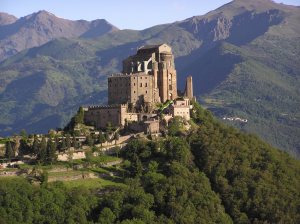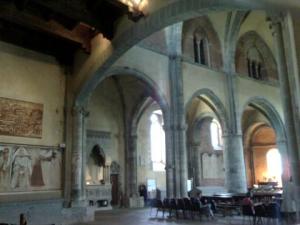 We’re heading back to the Val di Susa, west of Turin, where I must return to see this awesome sight, one of the largest Romanesque architectural complexes in Europe: the Sacra di San Michele.
We’re heading back to the Val di Susa, west of Turin, where I must return to see this awesome sight, one of the largest Romanesque architectural complexes in Europe: the Sacra di San Michele.  This spot is a favorite of Adrian Petersen , who created Italian Reflections, a wonderful resource for travelers and foreigners who’ve relocated to Piedmont and other regions of Italy. He also has written for ItalyItalia, the Nile Guide, and Wandering Educators. Adrian and his wife Sandy moved from the UK’s southwest to Italy three years ago, are now renovating a hill top country house in this Piedmont paradise, and love exploring the beautiful countryside that surrounds them.
This spot is a favorite of Adrian Petersen , who created Italian Reflections, a wonderful resource for travelers and foreigners who’ve relocated to Piedmont and other regions of Italy. He also has written for ItalyItalia, the Nile Guide, and Wandering Educators. Adrian and his wife Sandy moved from the UK’s southwest to Italy three years ago, are now renovating a hill top country house in this Piedmont paradise, and love exploring the beautiful countryside that surrounds them.
When the weather is clear, a Golden Day visiting the Sacra di San Michele would be divine. It sits atop Monte Pirchiriano, meaning “Mountain of the Pigs,” and as you approach it up the winding road from Sant’Ambrogio, the views of the valley and beyond to Turin are stunning. The final kilometer hike from the car park leads you through picturesque woods until you reach a small plateau where the whole complex comes into view.
 The contruction of this amazing place covers a span of 1000 years, beginning in 983, when Hugo de Montbossier, according to legend, was advised by angels that an Abbey should be built on this spot. Benedictine monks occupied the Abbey for 600 years, and it became a pilgrimage spot for the faithful. It was abandoned for 200 years, and then in 1836 became the home of the Rosminian Fathers, a religious community who occupies it to this day.
The contruction of this amazing place covers a span of 1000 years, beginning in 983, when Hugo de Montbossier, according to legend, was advised by angels that an Abbey should be built on this spot. Benedictine monks occupied the Abbey for 600 years, and it became a pilgrimage spot for the faithful. It was abandoned for 200 years, and then in 1836 became the home of the Rosminian Fathers, a religious community who occupies it to this day.
 There are lots of steps to climb to reach the church, finally taking you to the Scalone dei Morti, the “Staircase of the Dead,” where monk’s tombs once lined the walls.
There are lots of steps to climb to reach the church, finally taking you to the Scalone dei Morti, the “Staircase of the Dead,” where monk’s tombs once lined the walls.  At the top you’ll discover a 12th century Romanesque masterpiece, the “Porta dello Zodiaco,” with sculpted columns and archways, featuring scenes from biblical stories.
At the top you’ll discover a 12th century Romanesque masterpiece, the “Porta dello Zodiaco,” with sculpted columns and archways, featuring scenes from biblical stories.
 The church is a blend of Romanesque and Gothic design, with sarcophaguses from the Royal House of Savoy on the perimeter, frescoes, paintings, and
The church is a blend of Romanesque and Gothic design, with sarcophaguses from the Royal House of Savoy on the perimeter, frescoes, paintings, and  a triptych by Renaissance master Defendente Ferrari.
a triptych by Renaissance master Defendente Ferrari.
 Walking out the Monk’s door to the terrace, you’ll see an unfinished bell tower named after a legendary beauty named Alda, who, as the story goes, twice threw herself from the top of this spot. The first time, she jumped to escape soldiers of fortune, praying as she threw herself off the edge, and she miraculously survived. Then she did it again, believing in divine intervention, but fell to her death on the rocks below.
Walking out the Monk’s door to the terrace, you’ll see an unfinished bell tower named after a legendary beauty named Alda, who, as the story goes, twice threw herself from the top of this spot. The first time, she jumped to escape soldiers of fortune, praying as she threw herself off the edge, and she miraculously survived. Then she did it again, believing in divine intervention, but fell to her death on the rocks below.
After a visit to this astonishing place, Adrian recommends a couple of good spots for dinner.  For excellent pizza in delightful surroundings, there’s Toto e Macario (Corso Moncenisio, 12N, 10057 Sant’Amrogio di Torino, 011 932, Open 7-midnight, closed Mon). Or for upscale Piemontese specialties, such as Vitello Tonnato or Chicken Marengo, there’s Ristorante La Betulla (Strada Giaveno 29, 10090 S. Bernardino di Trana, 011 933 106). Chef Franco Giacomino oversees this award winning Slow Food restaurant.
For excellent pizza in delightful surroundings, there’s Toto e Macario (Corso Moncenisio, 12N, 10057 Sant’Amrogio di Torino, 011 932, Open 7-midnight, closed Mon). Or for upscale Piemontese specialties, such as Vitello Tonnato or Chicken Marengo, there’s Ristorante La Betulla (Strada Giaveno 29, 10090 S. Bernardino di Trana, 011 933 106). Chef Franco Giacomino oversees this award winning Slow Food restaurant.
 As far as places to stay, there’s the charming Hotel Chalet del Lago, a 3-star on the shore of Lago Grande. Or for more modern accommodations, there’s the River Hotel, surrounded by gardens, or the
As far as places to stay, there’s the charming Hotel Chalet del Lago, a 3-star on the shore of Lago Grande. Or for more modern accommodations, there’s the River Hotel, surrounded by gardens, or the  Rivoli, a 3-star with a pool.
Rivoli, a 3-star with a pool.
Grazie Adrian!
Note that the Sacra di San Michele is closed on Mondays. For visitor’s info: www.sacradisanmichele.com



Val di Susa has been on my wish list for a long time now, so thanks for these great suggestions. Why the name Mountain of the Pigs, I wonder?
Pirchiriano is the very ancient name of the mountain, from the word “Porcarianus” or “mountain of Pigs”, and is linked to the neighbouring peaks of “Caprasio”, or “mountain of Goats”, and “Musinè” or “mountain of Donkeys”.
We did visit some time ago, sadly they were just closing either for lunch or early for some reason I can’t remember. So we only got to see the entrance and the building from the outside. Time for a revisit!
ciao Lisa